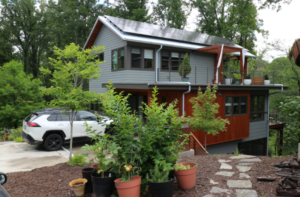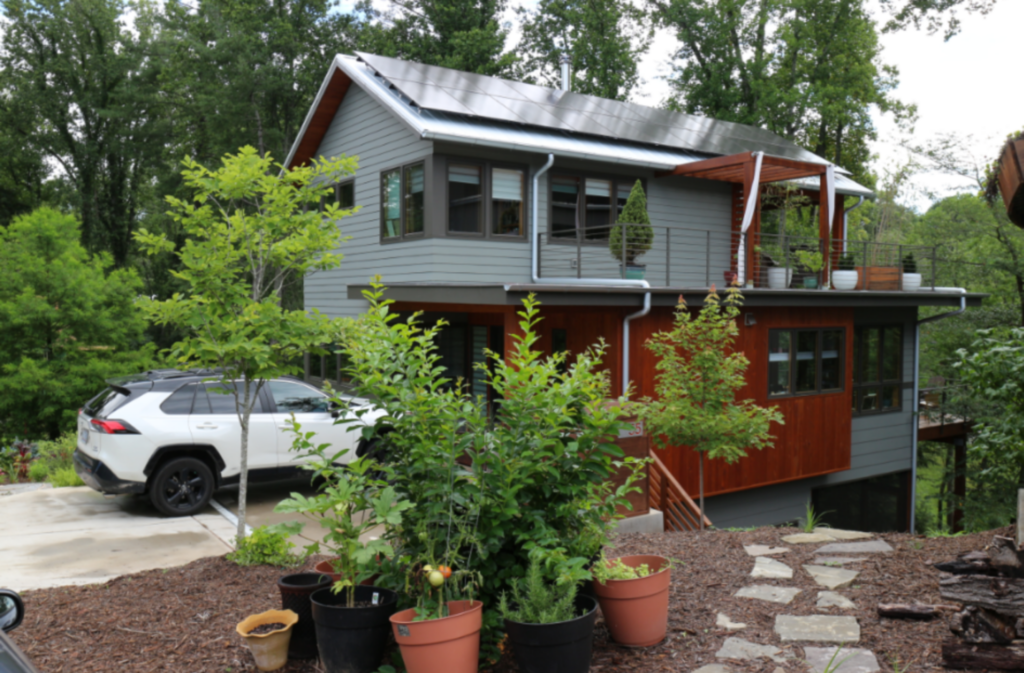
After 60 years of combined federal service at the U.S. Environmental Protection Agency, Tony Wayne and Kimber Scavo’s decision to build green was a logical extension of their lifelong work to address climate change.
When determining where to build their new green home, Asheville was also a no brainer.
“I am so impressed that Asheville is leading the way in North Carolina for sustainable residential architecture and that builders in this community are committed to a healthy environment and renewable energy,” Scavo said. “Renewable energy, like solar, is our future. We have to shift as a whole community to more sustainable practices for our planet and our own health.”
Landing a Home Energy Rating System (HERS) Score of -9 and achieving Green Built Homes’ Platinum Net Zero level of certification, the couple’s new home is located in the Shelburne Woods neighborhood being developed in West Asheville by Mountain Sun Building & Design.
In addition to the environmentally friendly and energy efficient homes, the subdivision features green spaces planted with native, edible plants and common areas along the creek that back up to the future Rhododendron Creek Greenway.
The homeowners moved from North Carolina’s Triangle Area, where they worked for the EPA, to Asheville to build a house that aligned with their core values.
The process of creating this green home started long before the building stage. A key early step was to determine the optimal position of the home to benefit from the ample natural light. The house’s structure would be incorporated into the existing landscape to minimize interruption to the native ecology.
On this piece of property, several large poplars needed to be cut down to make room for the home. These trees were milled and used to clad ceilings and walls in the home.
The paint used on the house was also important to the homeowners. In working with the EPA, they knew that paint containing volatile organic compounds (VOCs) contributes to indoor air pollution as well as ground-level ozone, which is harmful to human health. The house was painted with VOC-free paint to reduce the release of carcinogens into the atmosphere.
To ensure efficiency, the home is equipped with EPA-certified WaterSense fixtures that use less water than other products. The home is also well insulated with spray foam to minimize air leakage.
“There’s no uninsulated or unconditioned space in the house,” Mountain Sun Cofounder Emily Boyd said.
The first priority is to build the most energy-efficient home possible before adding solar to the equation. When a house has energy-efficient appliances and fixtures, tight insulation and a high-performing HVAC system, a smaller photovoltaic array can generate more than enough energy to power the home.
Beyond the components built into the house that delivered its stellar HERS Score, the location also plays a role. This home was built in an in-fill location on a lot within an existing neighborhood where amenities and resources are already available. Another benefit to the ecological footprint is the walkable location in an already developed, green neighborhood. And when adventure calls and driving is a must, the solar panels atop the home power a car-charging station in the parking area.
Though the homeowners have now relocated to Asheville, Scavo still works remotely with the EPA.
“I have decided to stay at EPA because we are doing exciting things now addressing climate change and supporting renewable energy,” she said. “I have high hopes that the Raleigh-Durham area will look to Asheville and start making similar choices in more sustainable residential builds.”
Hannah McLeod is a reporter at Smoky Mountain News, with which Green Built Alliance partners to publish its annual Green Building Directory.
You can also view this article as it was originally published on page 22 of the 2021-22 edition of the directory.


